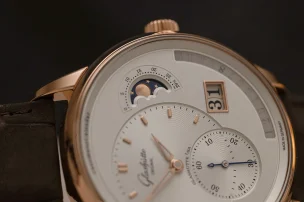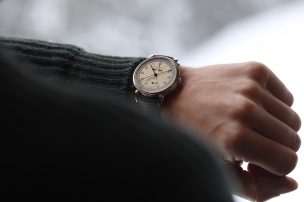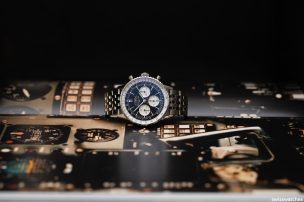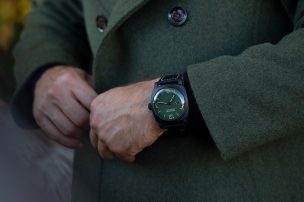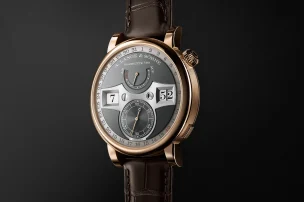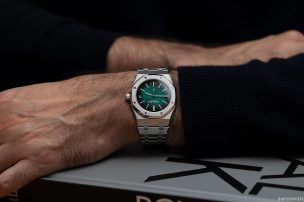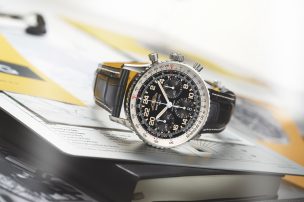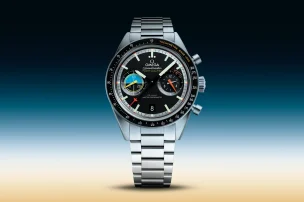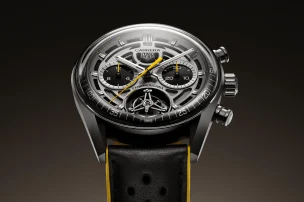
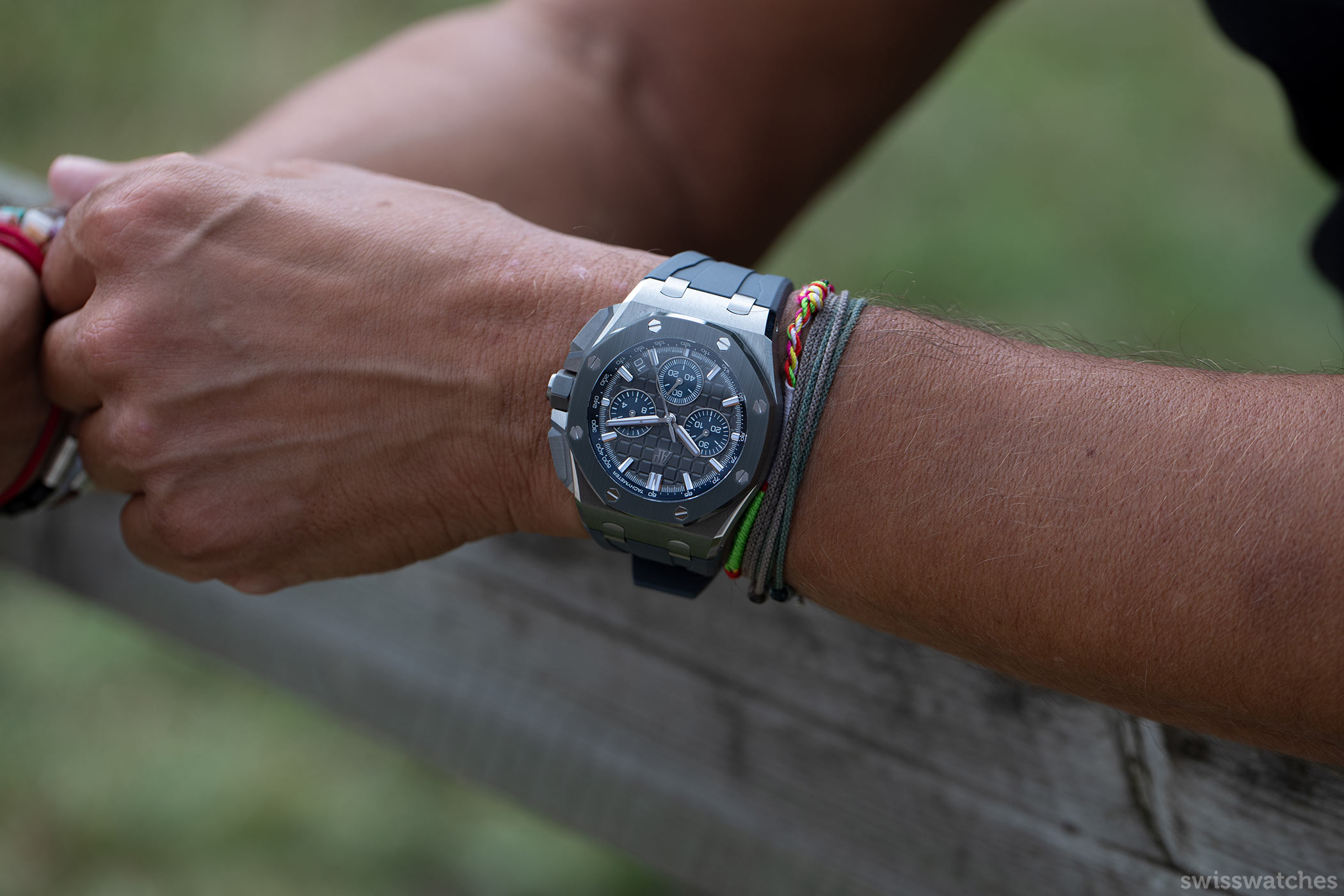
In The Metal: Audemars Piguet Royal Oak Offshore 43 mm With Manufacture Calibre 4401
“Ergonomic: [adjective] relating to or designed for efficiency and comfort in the working environment.” This is the definition for the word “ergonomic”; a buzz word at Audemars Piguet this year, since the Swiss horology house introduced its all-new Royal Oak Offshore models in a 43 mm case. The new chronograph models, available in steel, pink gold, or titanium, have not only a more ‘ergonomically refined design’, but also boast of ‘optimum aesthetics’ and a new strap system. So how should we interpret these novel pieces that mark the line’s first big redesign since the 2000s? Let’s review the 2021 collection and find out.

The DNA of the Royal Oak Offshore
Everyone knows that the Royal Oak is one of the most iconic (not a word to use lightly, of course) models out there. Conceived by Gerald Genta and taking inspiration from diver’s helmets, the model from 1972 is recognisable thanks to its octagonal bezel, exposed hexagonal screws, and tapisserie dial. Also known as the world’s first luxury steel sports watch with an integrated bracelet, it remains one of the most revered pieces in the watch world. So where does its relative, the Royal Oak Offshore, fit in?

Upon its initial conception as an anniversary model for the Royal Oak in 1993, the watch made a powerful statement. Nevertheless, it was not originally destined to become a collection in its own right. Rather, following several years of dwindling sales for the Royal Oak, AP hoped that the first Offshore would reignite an interest in the line. Appearing in a 42 mm case, the original model challenged watch conventions with a then-sizeable diameter – even for a sports watch – alongside some contemporary rubber details on the crown and pushers. Furthermore, it took the Royal Oak‘s athletic appearance up a notch with the introduction of a chronograph.
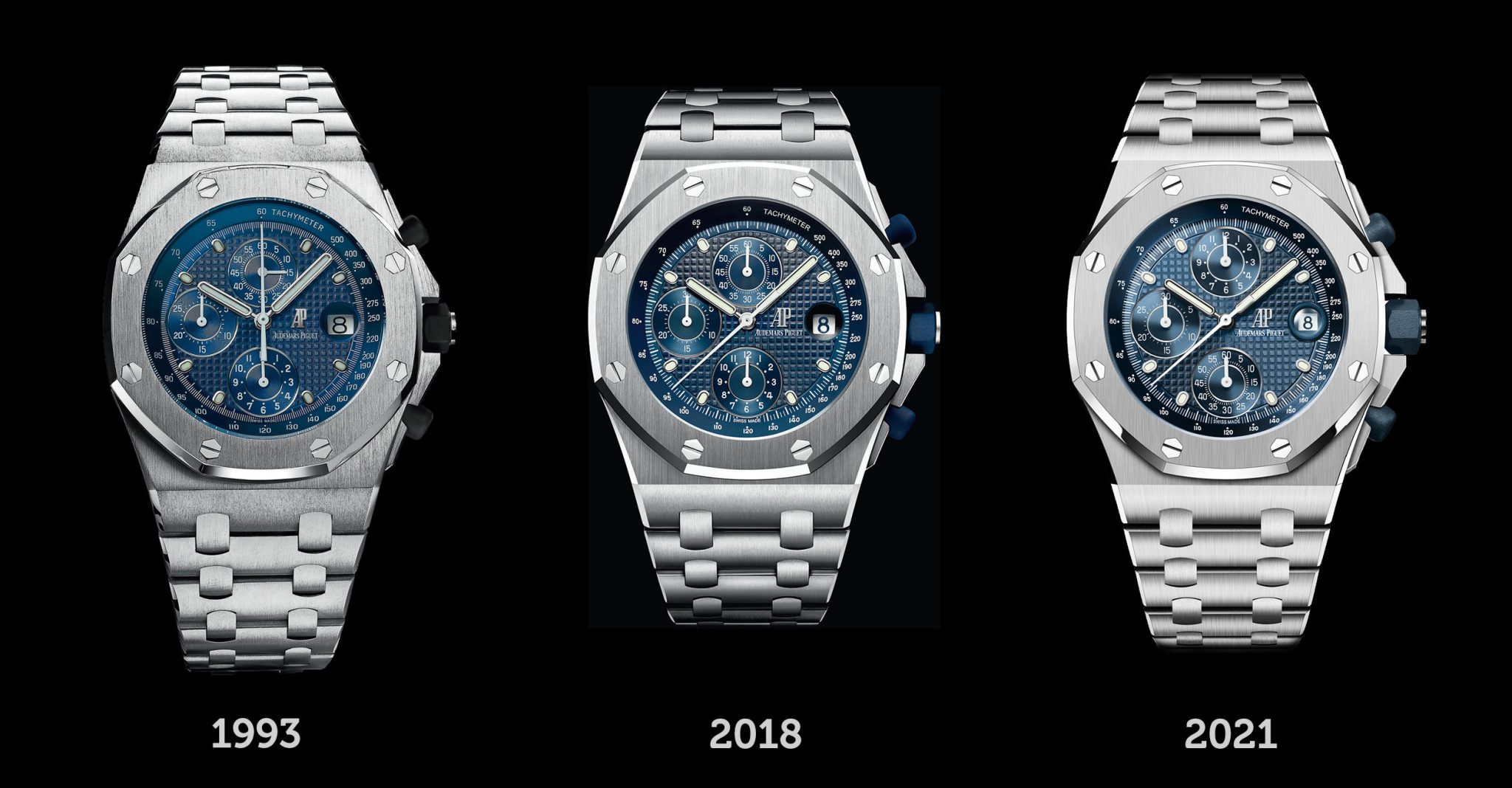
This was no easy feat for the watchmaker. Observant readers will have noted that the Royal Oak’s anniversary was actually in ’92, however the complicated engineering of the Offshore meant that the watchmaker required an extra year before it could be launched.
A difficult design
Obstacles facing the Offshore’s 22 year-old Swiss designer, Emmanuel Gueit, included integrating a chronograph module into the JLC calibre 888, as well as an anti-magnetic soft-iron cage to maintain precision. Furthermore, the already decorated dial now needed the additional feature of a tachymeter scale. Nevertheless, the young Gueit felt little pressure. His brief from AP was simple: “Create something young men would want to wear.” Thanks to his youthful confidence, Gueit once remarked, he “didn’t really care about taking risks with the watch.”
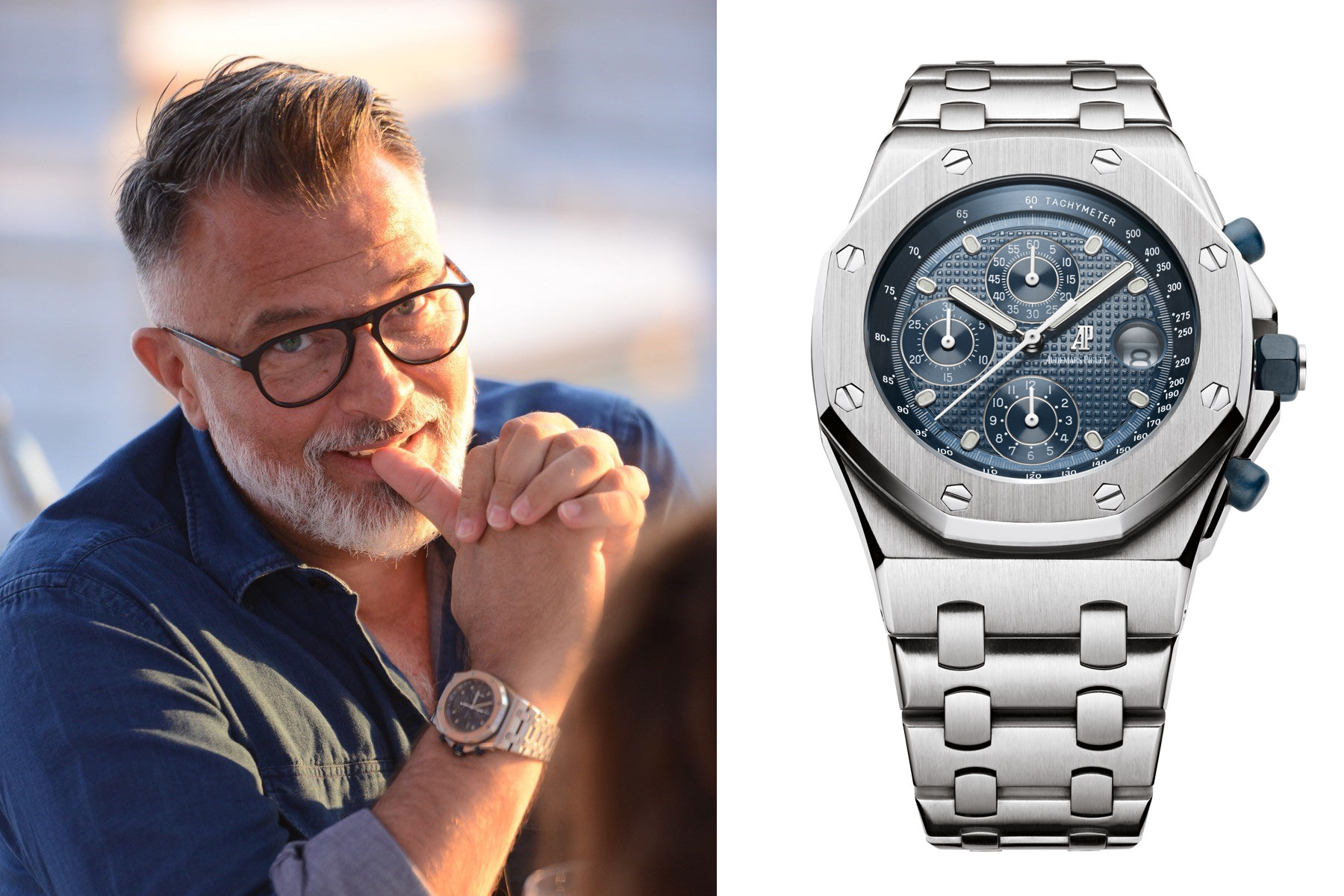
Fortunately, this nonchalant approach eventually paid off. Following a fairly frosty reception from fans – as well as Royal Oak designer Genta himself – the watch, aptly nicknamed ‘The Beast‘, finally found its salvation when Olympic gold medalist Alberto Tomba began to wear the Offshore, inspiring other young Italians to do the same. As is arguably the case with the Code 11.59, the new model did not necessarily please its current customers. However, it did entice new, younger ones, with the watch’s reputation and success flourishing over the years.
Royal Oak Offshore 43 mm: Case materials
The new 43 mm models’ cases come, as mentioned, in three different materials: steel, 18-carat pink gold, and titanium. The Royal Oak Offshore initially appeared only in steel. However, it was not long before AP began to experiment with materials, starting by introducing a full yellow-gold model in 1996. This already indicated that Audemars Piguet was willing to abandon conventions by creating a sports watch using precious metals. It also emphasised that the Offshore was a model meant for everyday use as well as sporting activities (the cases are water-resistant to 100 m). AP even experimented with an incredibly rare two-tone pink gold and steel version (there are only about four known pieces in existence). Then, at Baselworld the next year, a perpetual calendar Offshore appeared in white gold. This was followed by editions not only in steel, but also pink gold and titanium.
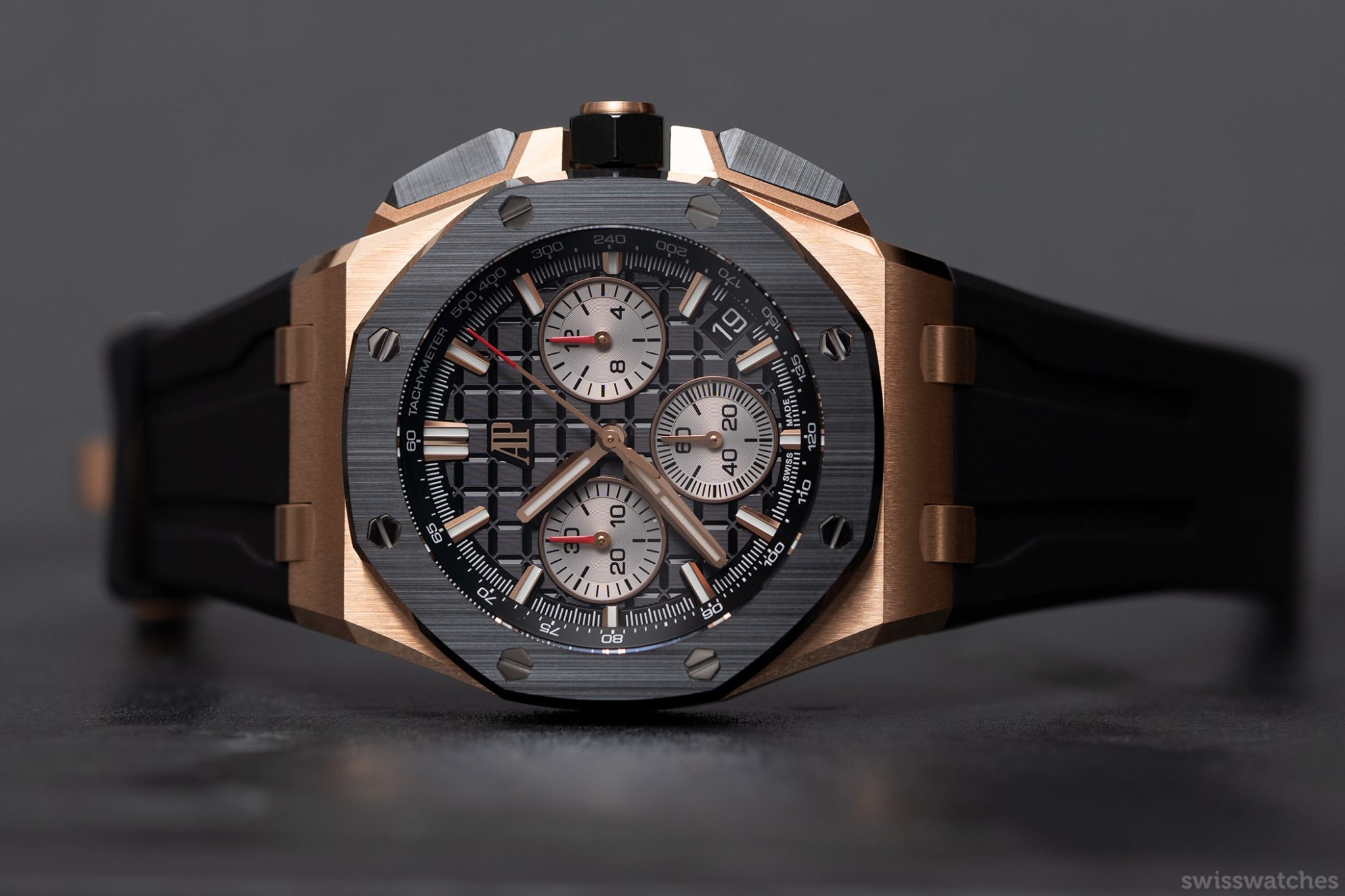
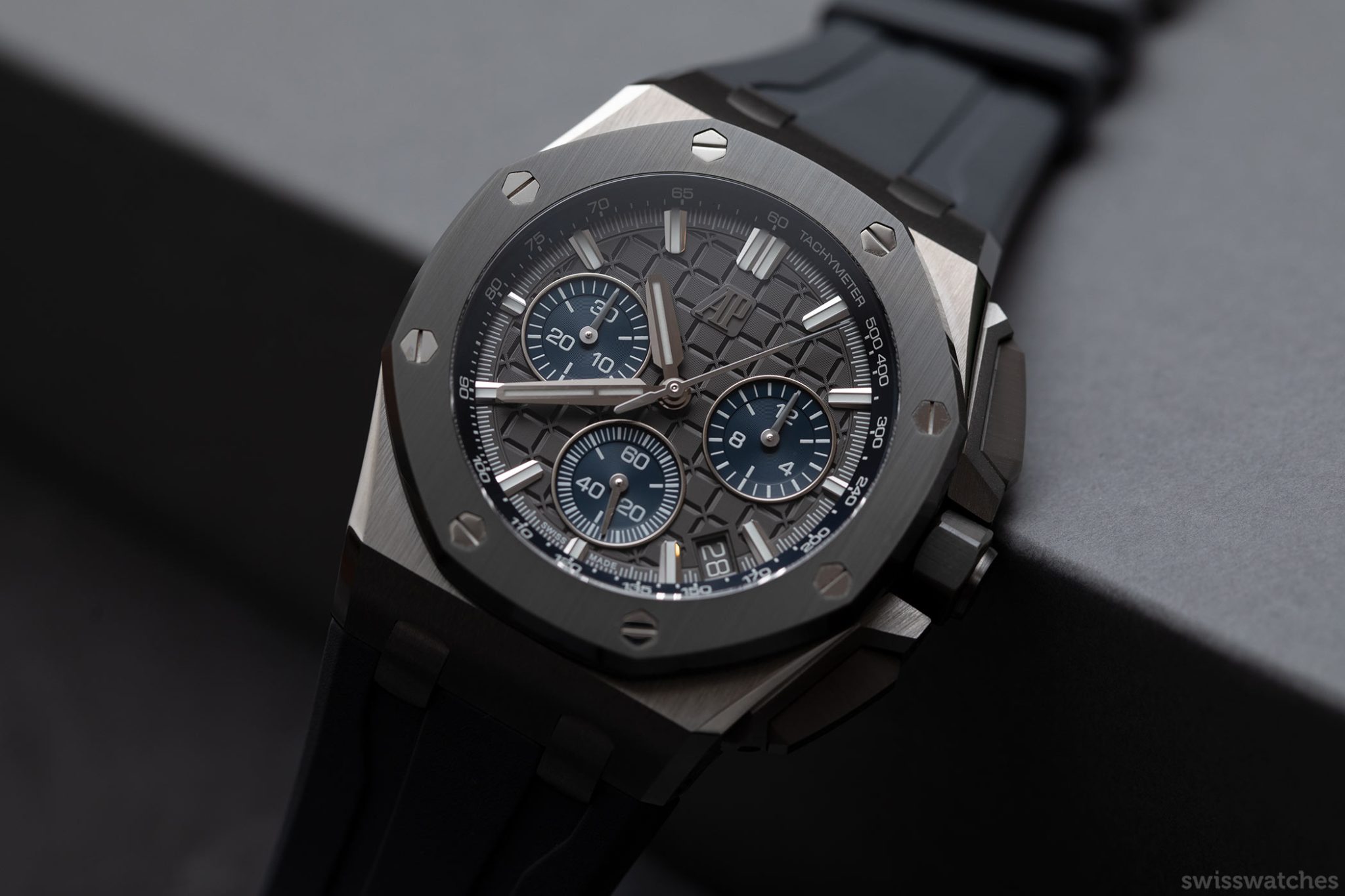
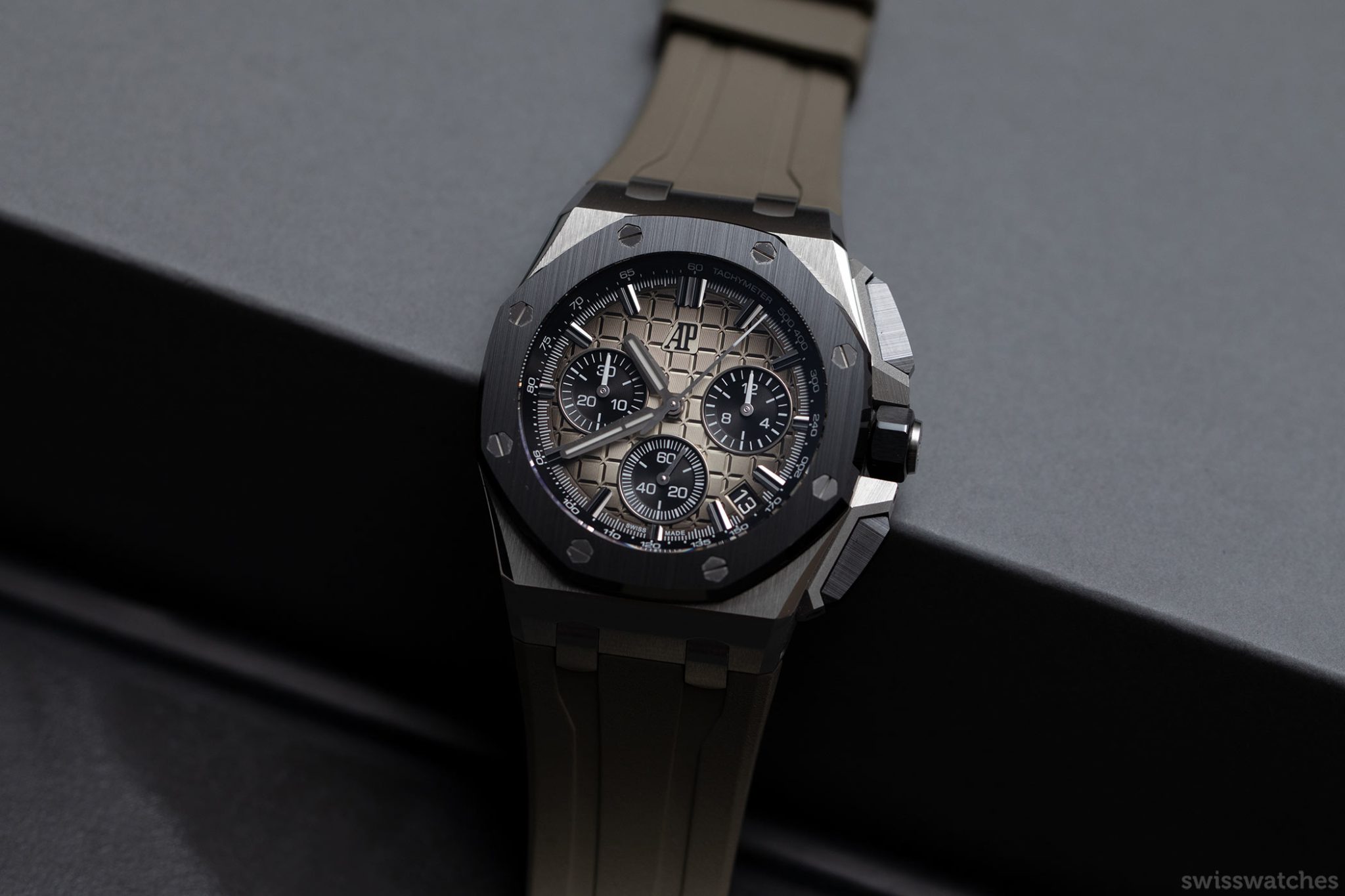
Thus, the current case materials of the 43 mm models (pink gold, steel, and titanium) have long been in the game. Audemars Piguet is more than comfortable with offering a range of materials for its contemporary looking Offshores. The most typical case options include ceramic, steel, titanium and pink gold. The rarest material within the line is actually white-gold. It is currently only available in the case of the limited 42 mm Royal Oak Offshore Diver (Ref. 15720CN.OO.A002CA.01), and a diamond-clad special edition (Ref. 26473BC.ZZ.8043BC.01).

The new size
So, is the change in case size important? Well, remember the uproar when Rolex increased the size of the Submariner by 1 mm back in 2020? It was huge news; in fact, incredibly, our coverage of it remained amongst our most-read articles for well over a year. The significance for many was the concept of wearability, and the same applies to the Royal Oak Offshore.
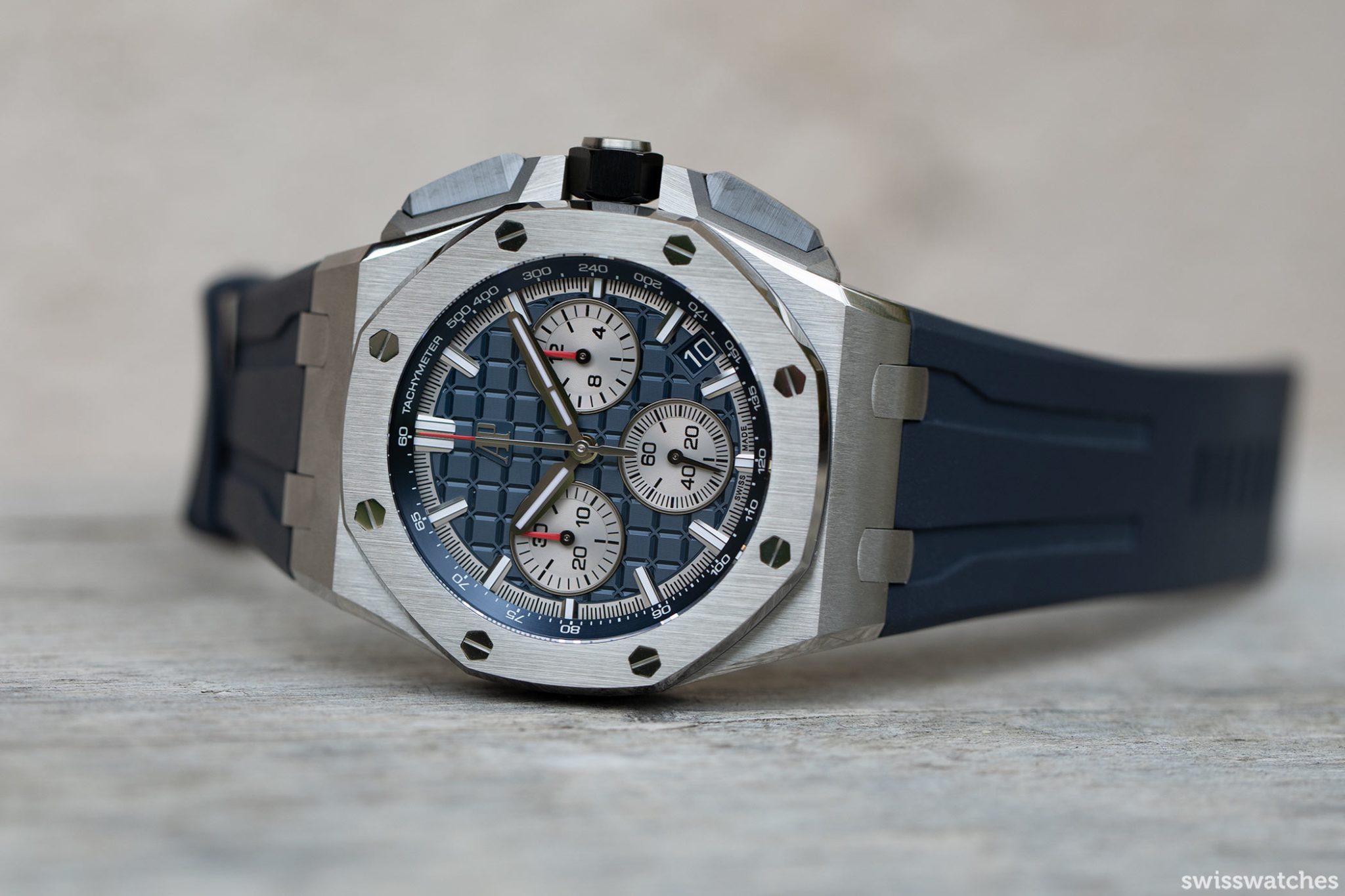
The new 43 mm might sound on the large side. But let’s not forget the brand has been playing with 44 mm cases ever since the 2000s. Furthermore, I can confirm that the new Offshore models sit very well on the average male wrist. If you look from lug to lug on both versions, you see that the watch doesn’t even look oversized. Additionally, true to its ‘ergonomic’ design, the size simply helps the 43 mm Offshore on its way to being a highly legible chronograph.
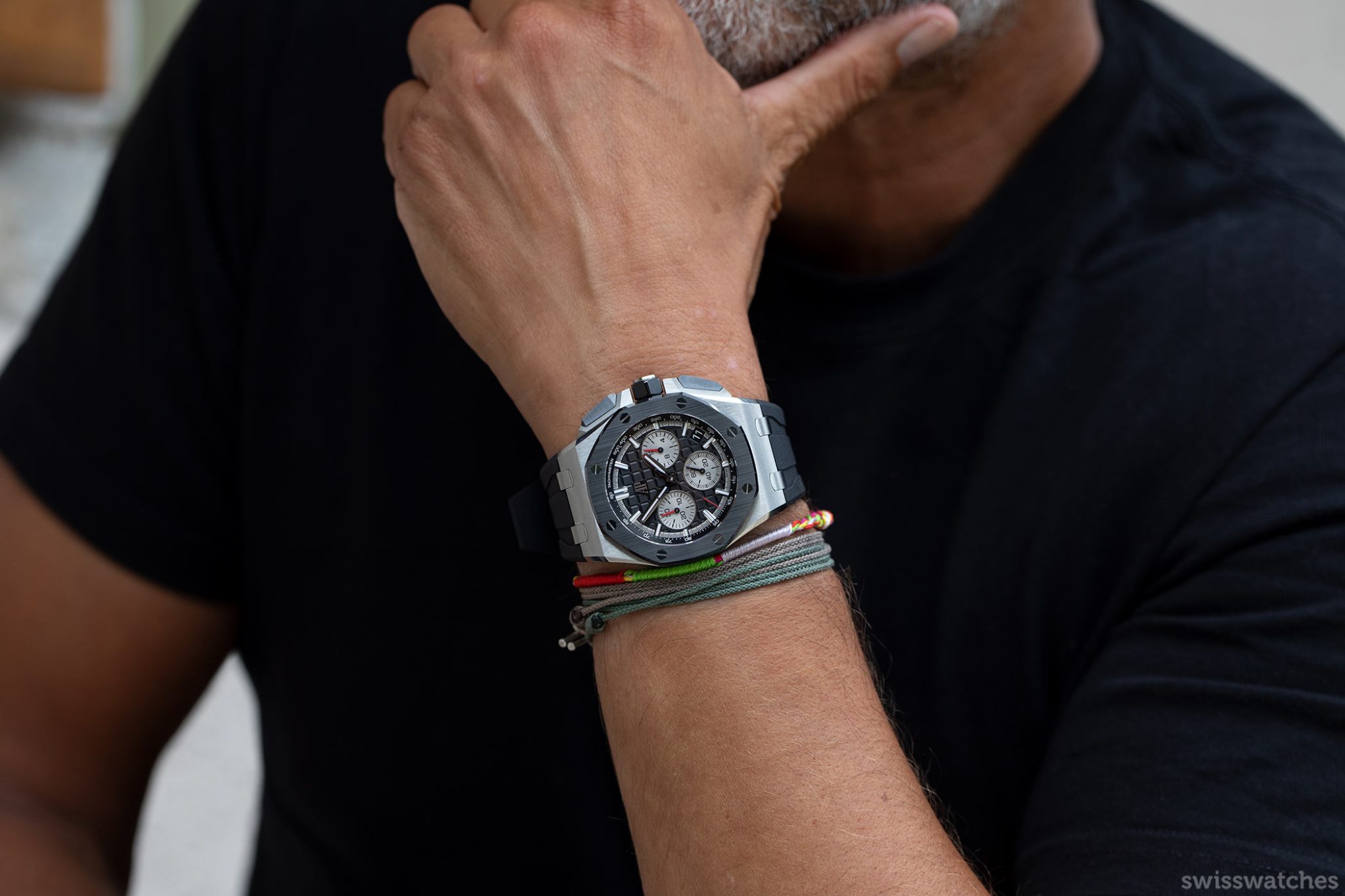
Nevertheless, the Offshore remains an overtly masculine watch, and doesn’t shy away from the limelight. For this reason, I wouldn’t recommend wearing the model to a formal event or location, much less in the evening. As mentioned, it’s more a watch for creating a casual everyday or weekend look. This brings us to the dials and general aesthetic of the new models.
Ever-evolving dials
Tapisserie is key
The choice of engine-turned tapisserie is always an all-important question at Audemars Piguet – with the Offshore serving as an opportunity to play around with various options. The Grande Tapisserie style introduced in 1999 saw the pyramid pattern almost double in size. While first appearing in the main Royal Oak collection, it appeared on the Offshore‘s 42 mm models soon after.
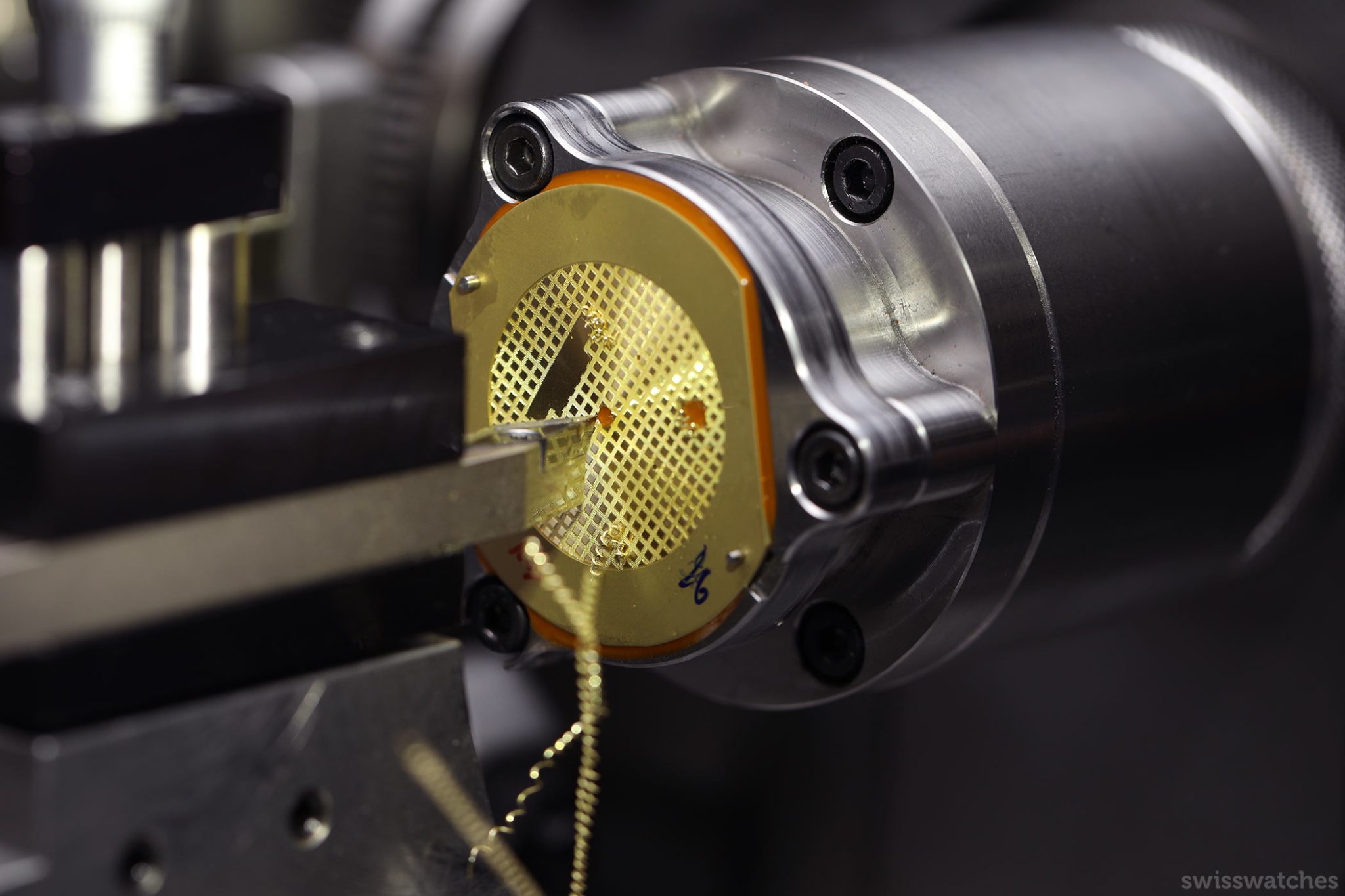
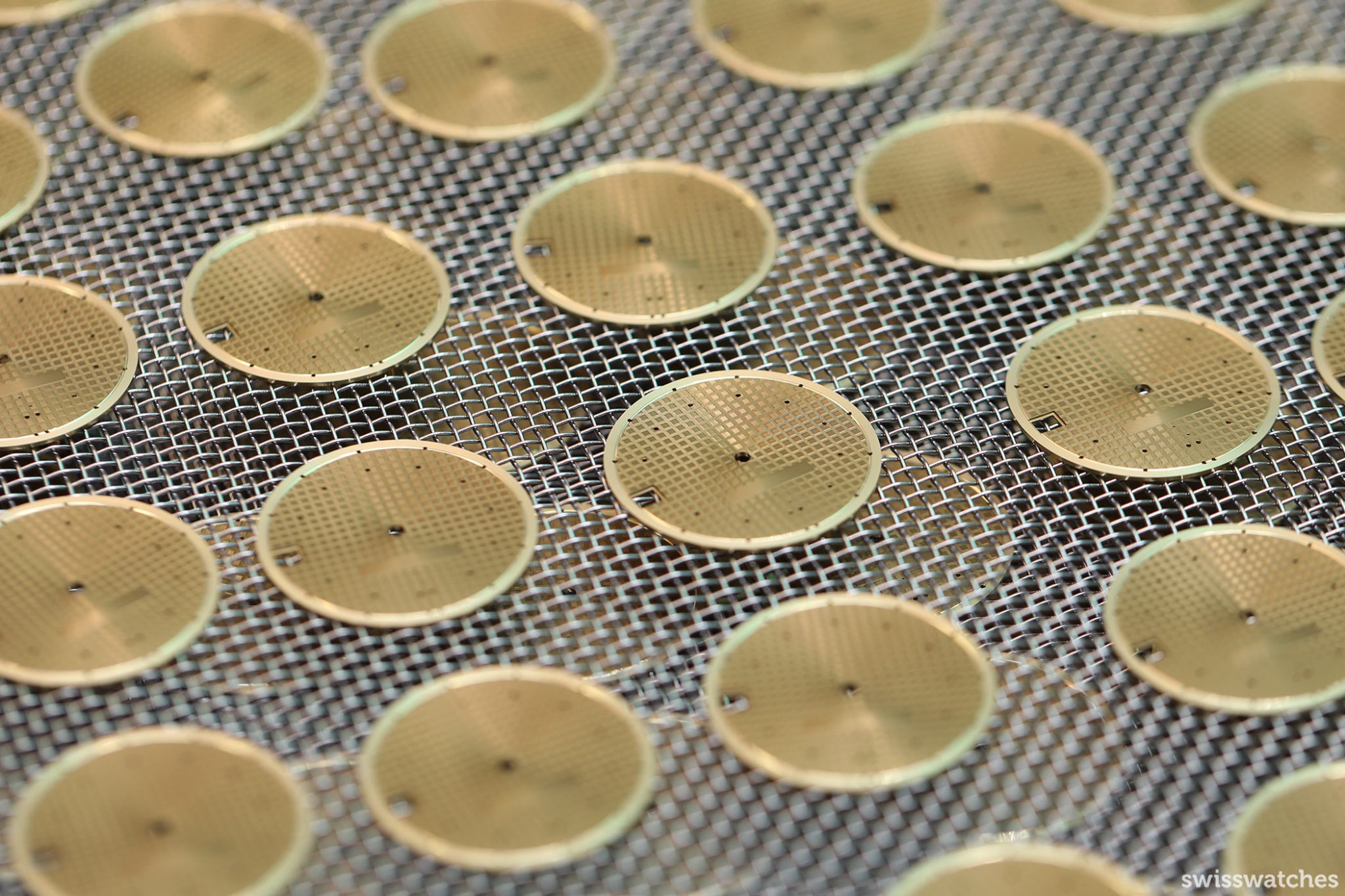
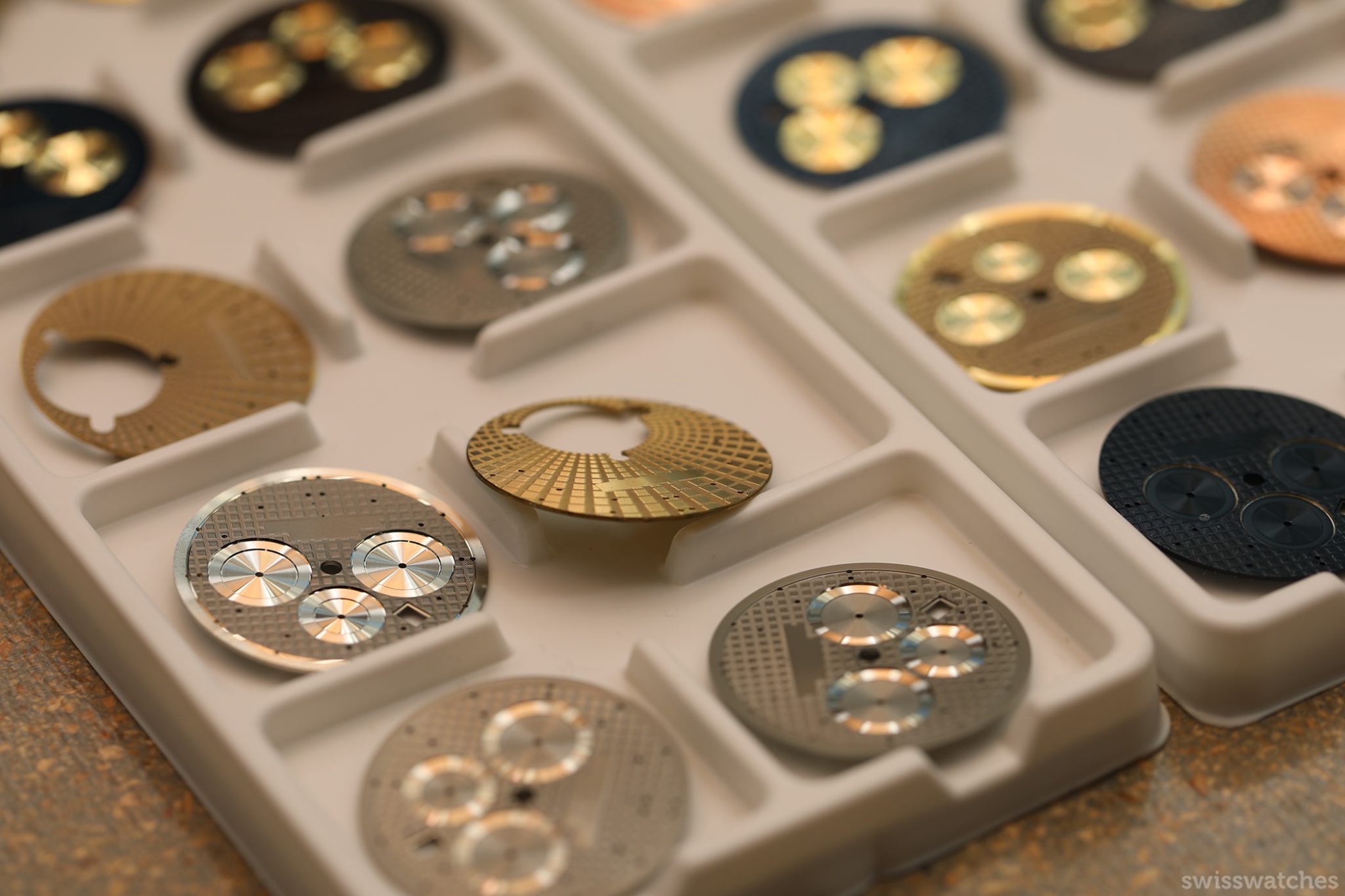
Three years on, in 2001, the Extra-Grande Tapisserie enters the Offshore line, later to be renamed Méga Tapisserie. This pattern, however, was not engine-turned like the majority of tapisserie dials. Rather, the process involves stamping the dial with powerful presses. Today, Méga Tapisseri is well-known for featuring in the 44 mm Offshore models that have been in production since 2010. The new interpretation on the 43 mm models, however, marks a new style of Méga Tapisserie, with what AP call a ‘criss-cross’ pattern.

Each of the 43 mm watches’ dials feature this ‘criss-crossing’ Méga Tapisserie decoration. The quality of the finishing is evident to see, both with or without a loupe. Each of the tapisserie ‘pyramids’ has not only be given a satin finishing but has also been sharpened and connected to the next ‘pyramid’. This adds an extra dose of depth to the line’s new statement dials. In order to create this bold yet fluid look, AP spent a significant amount of time experimenting with prototype dials before finally reaching a motif they were satisfied with.
Royal Oak Offshore 43 mm: Host to a new layout
The new dials come in various tones of black, grey, light brown or blue. In contrast to the previous models, the 2021 dials’ colour schemes experiment with higher contrasts. The result is a quintet of clean-cut, contemporary and clear-to-read chronographs.
Using Méga Tapisserie makes sense in order to allow the chronograph function to be as legible as possible. The brand also rearranged the chrono subcounters to improve readability yet further. The minute counter now appears at 9 o’clock, while the hour counter is positioned at 3 o’clock. Small seconds are at 6 o’clock.
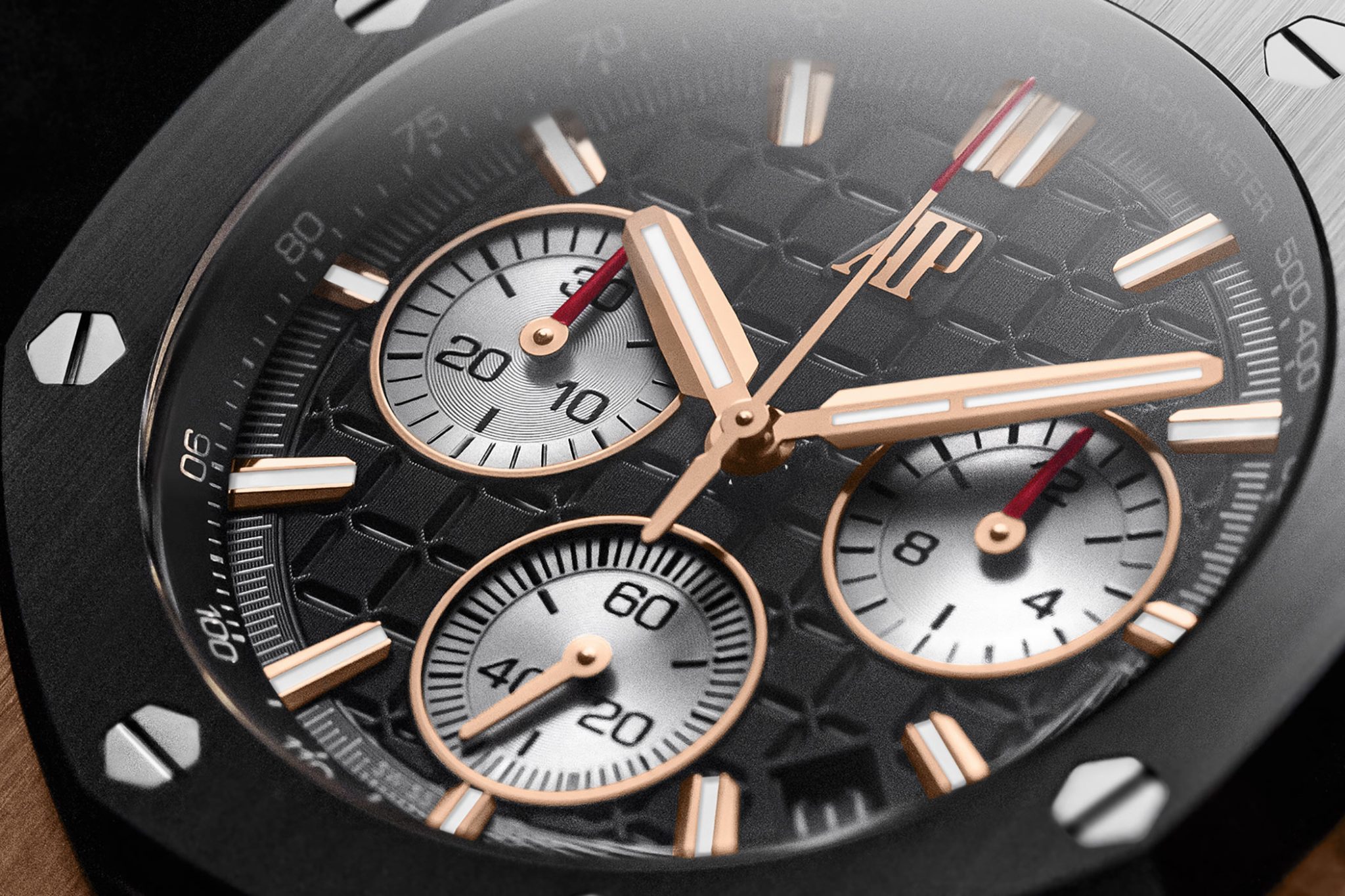
In addition, the date window has been moved closer to the inner bezel between 4 and 5 o’clock. This experimental placement of the date window is pretty typical for the Offshore – never one for being a crowd-pleaser. Notably, the addition of a new calibre with a further-forward date wheel also enables the new models to go without a cyclops lens over the date window. Last but not least, the luminescent-filled hands are now bolder than ever, meaning the time remains equally easy to read.
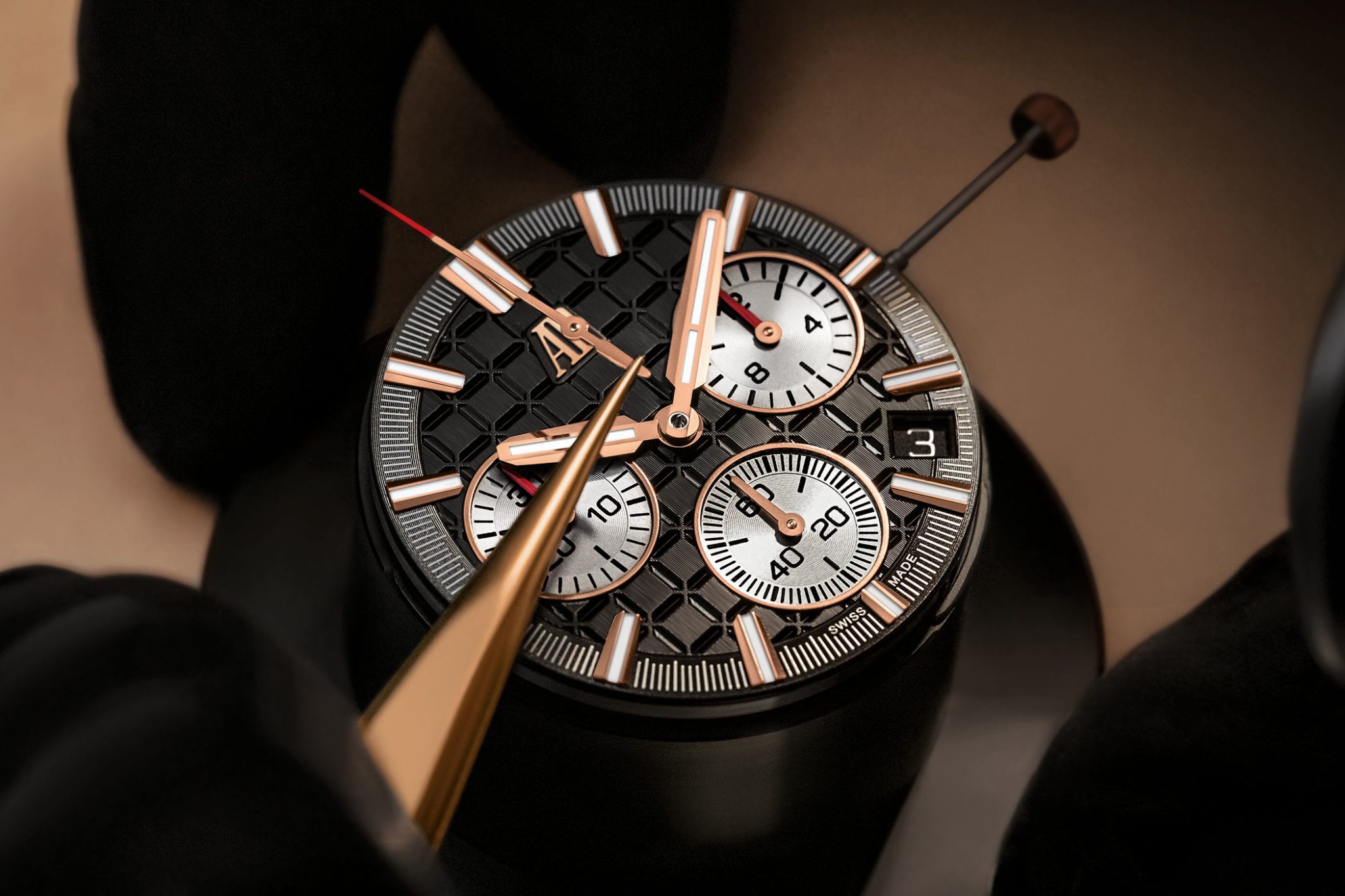
Another noteworthy point about these new dials is the logo. While the hot topic at the maison tends to be the Code 11.59 collection’s logo, achieved using the process of galvanic growth, the logo on the new models is also novel to the Royal Oak Offshore. The simple gold AP initials at 12 o’clock are a wise and minimalist choice by AP that keep the dial from becoming too cluttered.
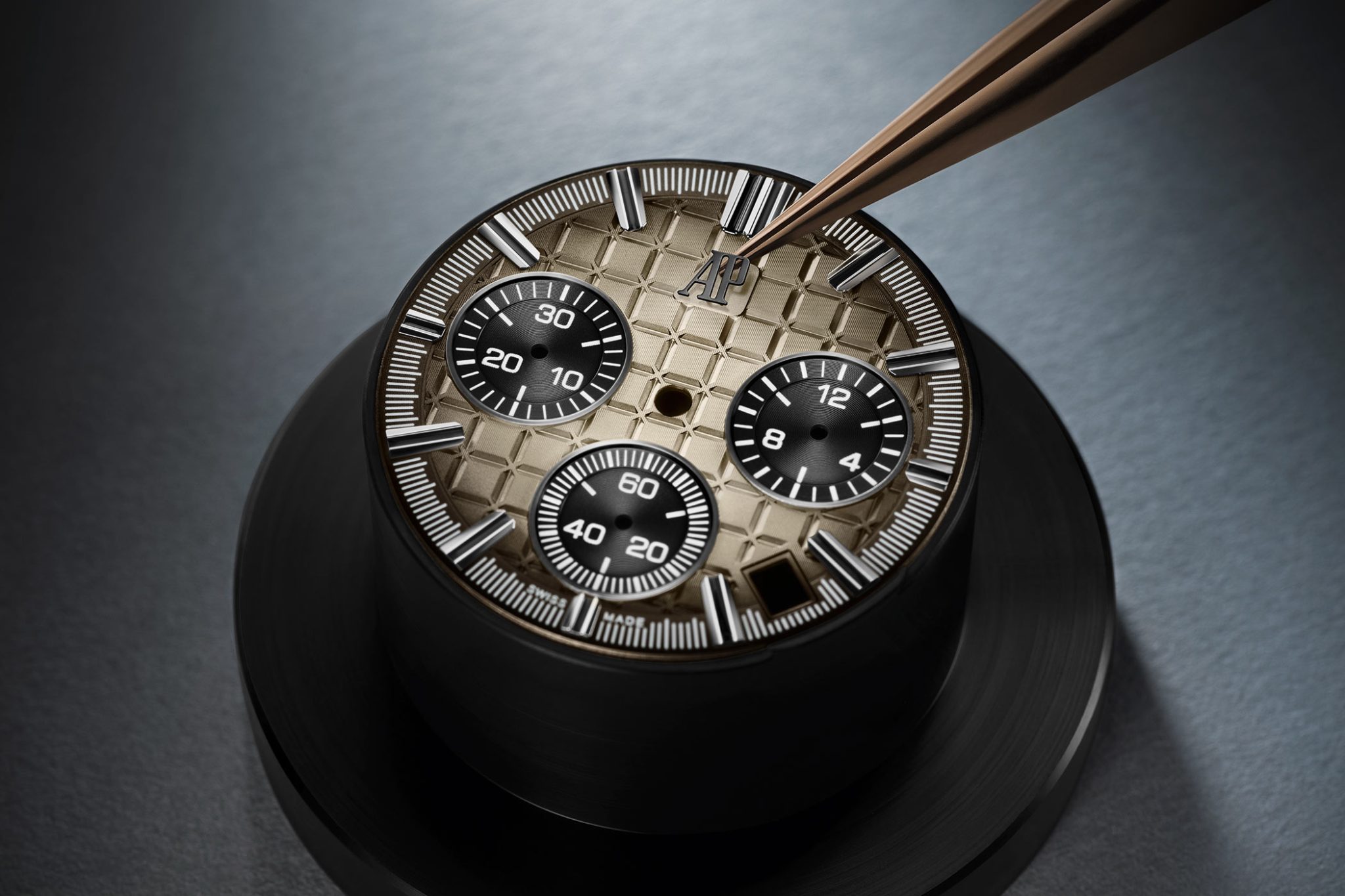
Landmark moment: An in-house movement
A key novelty that presents itself in the new 43 mm Offshore models is the introduction of AP’s latest integrated flyback chronograph, the calibre 4401, into the line. To cover the key points: the 4401 is a self-winding chronograph movement featuring a column wheel and flyback function, which allows the wearer to restart the chrono without stopping or resetting it first. Furthermore, the movement’s vertical clutch system prevents hands from jumping when the chrono starts or stops. Notably, the chrono’s pushers are pleasingly smooth to press. Additionally, the calibre’s patented zero resetting mechanism ensures that each one of the counter hands seamlessly resets. The calibre provides 70 hours of power reserve, and beats at a frequency of 4 Hz.
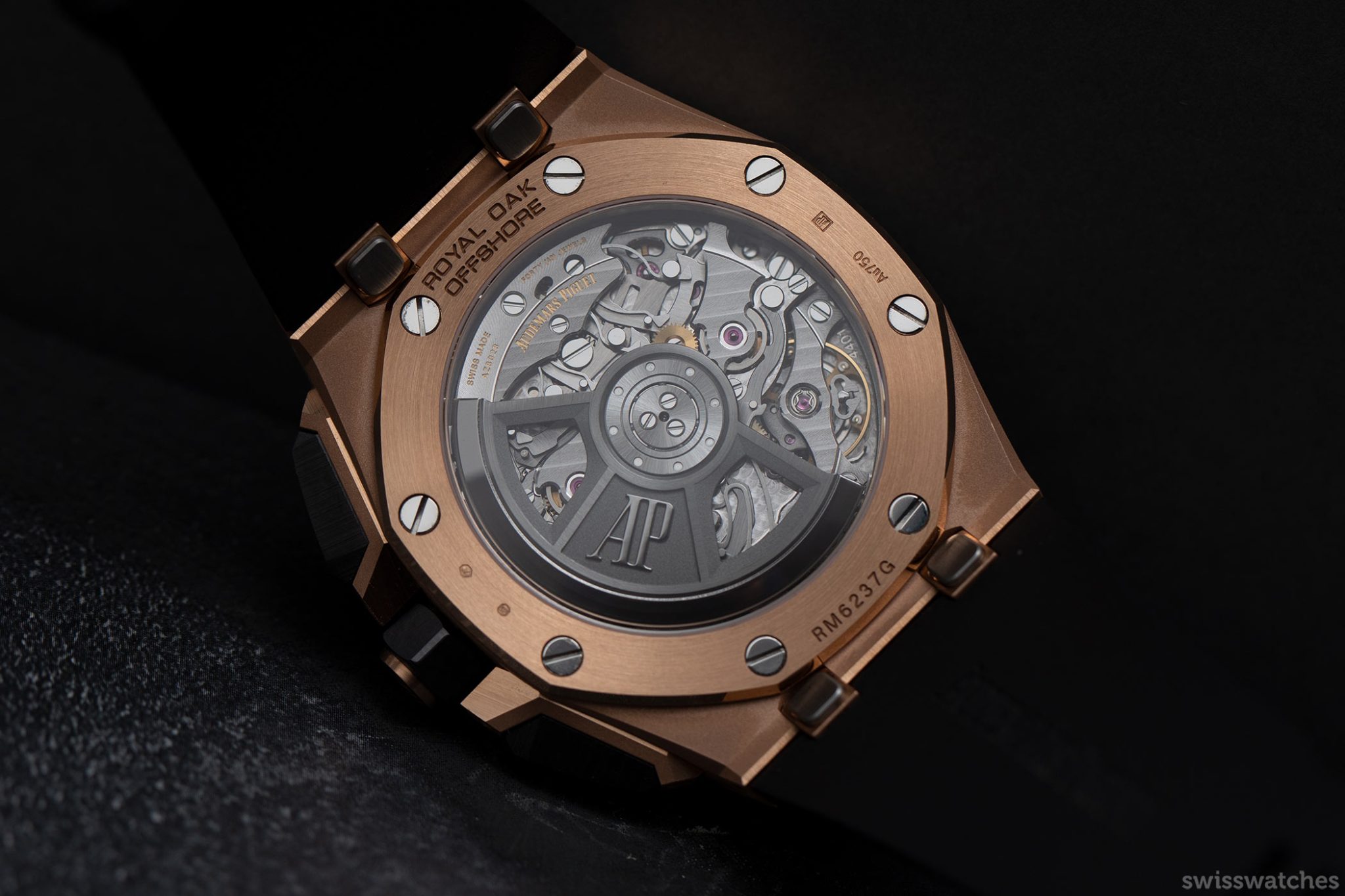
The calibre is also highly and beautifully decorated. Visible via the caseback, the 22-carat pink gold oscillating weight has been blackened, matching the collection’s powerful vibe with dark elements. Meanwhile, elegant decoration of the movement includes Côtes de Genève, “traits tirés” and circular graining. The caseback also reveals components usually hidden to the wearer. This includes the column wheel as well as the so-called “dance” of the chronograph hammers. When the reset button is activated, the hammers, driven by an operating lever, hit the chronograph’s heart-piece cams, bringing the chronograph wheels and hands back to zero.
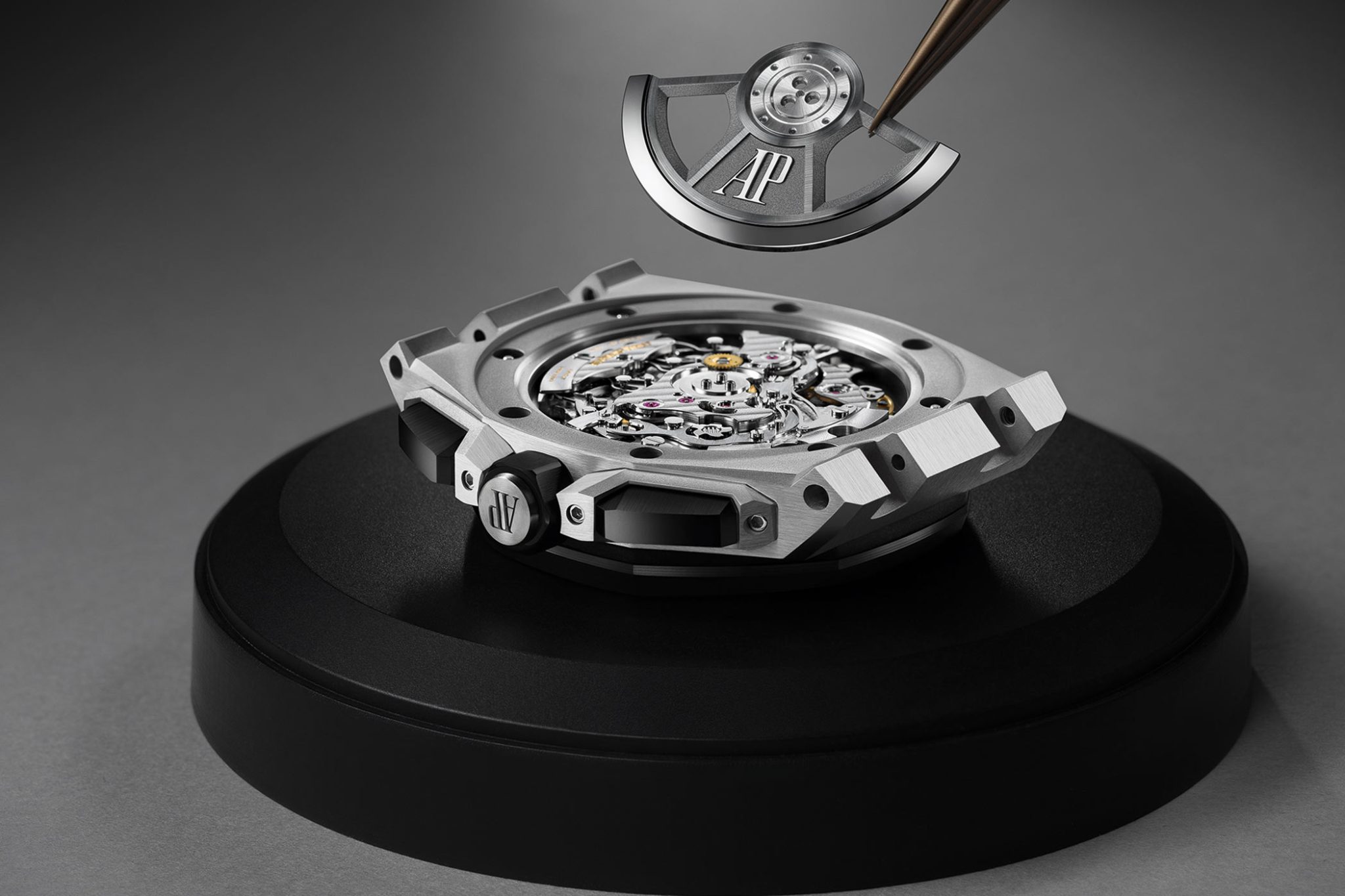
The calibre 4401 takes on a new collection
Observant Offshore aficionados will be aware that while the calibre 4401 is not new, having first appeared in the Code 11.59 collection, it is the first in-house chronograph movement to power the Offshore. Previously, the models would build upon base calibres, adding in chronograph modules, with the likes of Jaeger-LeCoultre’s calibre 888 and 889/1 or F. Piguet (now Blancpain) calibre 1185. Of course, the exception is the in-house calibre 3126/3840. However, this again built upon a base calibre without a chrono function.
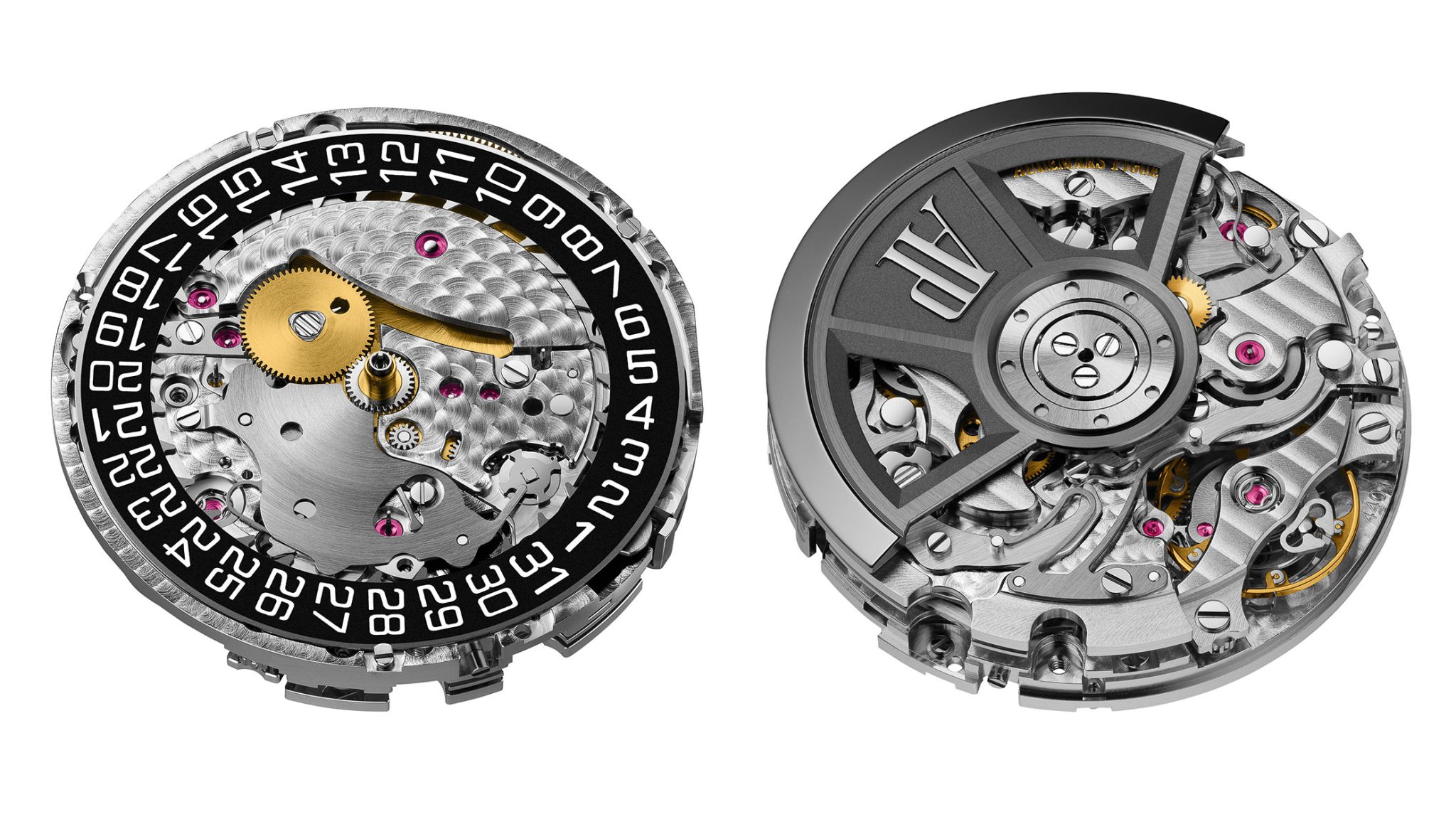
Many of us were wondering when the horology house would utilise its brilliant (for the multitude of reasons listed above) calibre 4401 outside of its Code 11.59 line. Now, we have the answer, with the 43 mm models marking the first time another collection’s models have been powered with the manufacture movement. It’s an honour for the Offshore, not to mention an indicator for the respect and promise the collection is regarded with at Audemars Piguet.
New system, new straps
While initially only available with a bracelet, Baselworld 1996 saw the introduction of eight colourful new Offshore models, all of which featured colourful leather straps for the very first time. The bright watches and the accompanying straps were another signal that Audemars Piguet considered the Offshore a collection to play around with, without the restrictions of strict design codes to conform to.
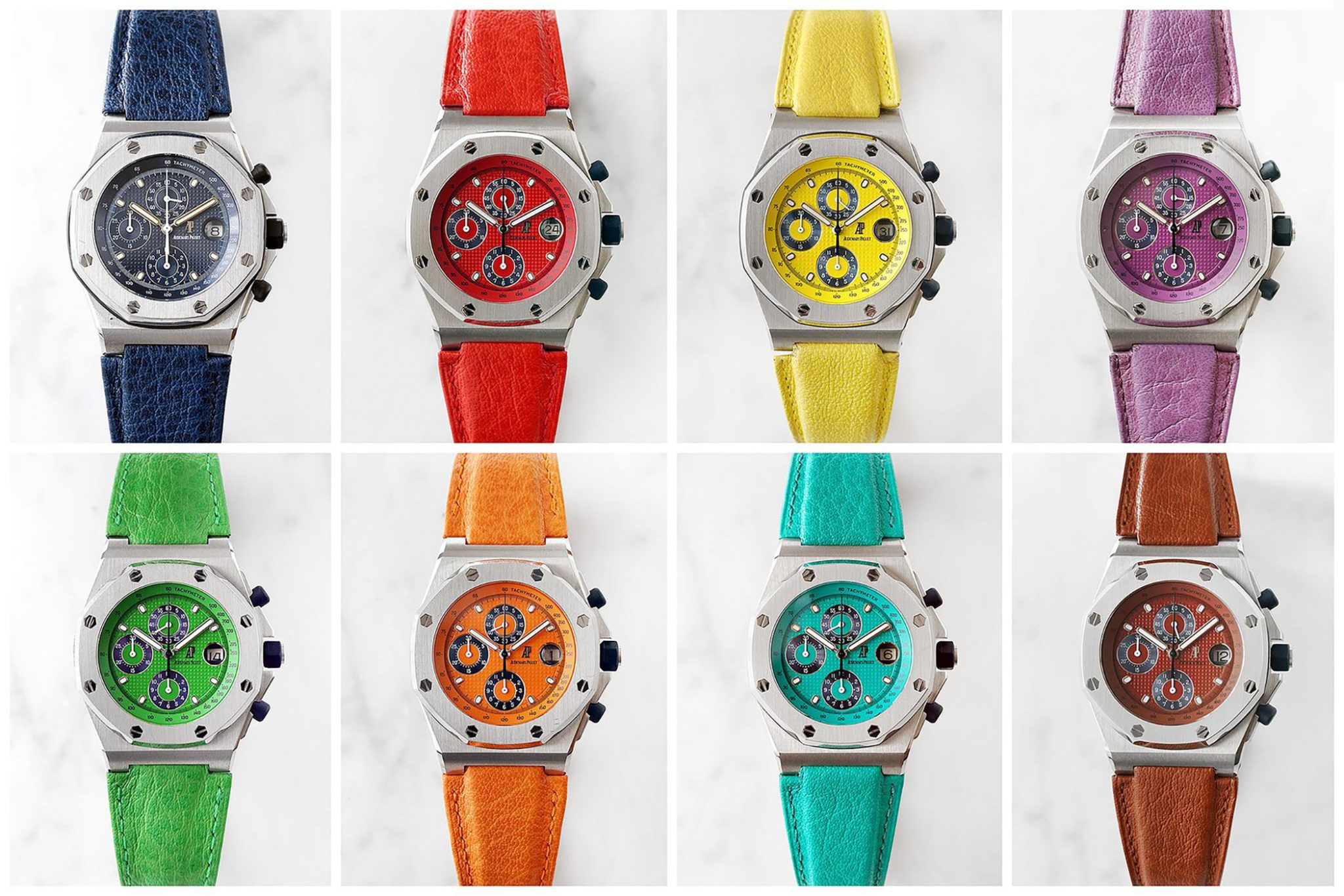
Eight colourful Royal Oak Offshore models at Baselworld 1996
credit © phillips.com
The modern 43 mm Offshore watches come with chunky rubber straps in either black, blue, grey or brown, with an AP pin buckle to fasten them. Notably, the straps are interchangeable, using the manufacture’s recently introduced quick-release strap system, which see the strap integrate directly into the buckle and case’s studs. This means that the wearer can simply ‘click and release’ in order to opt for a different look.
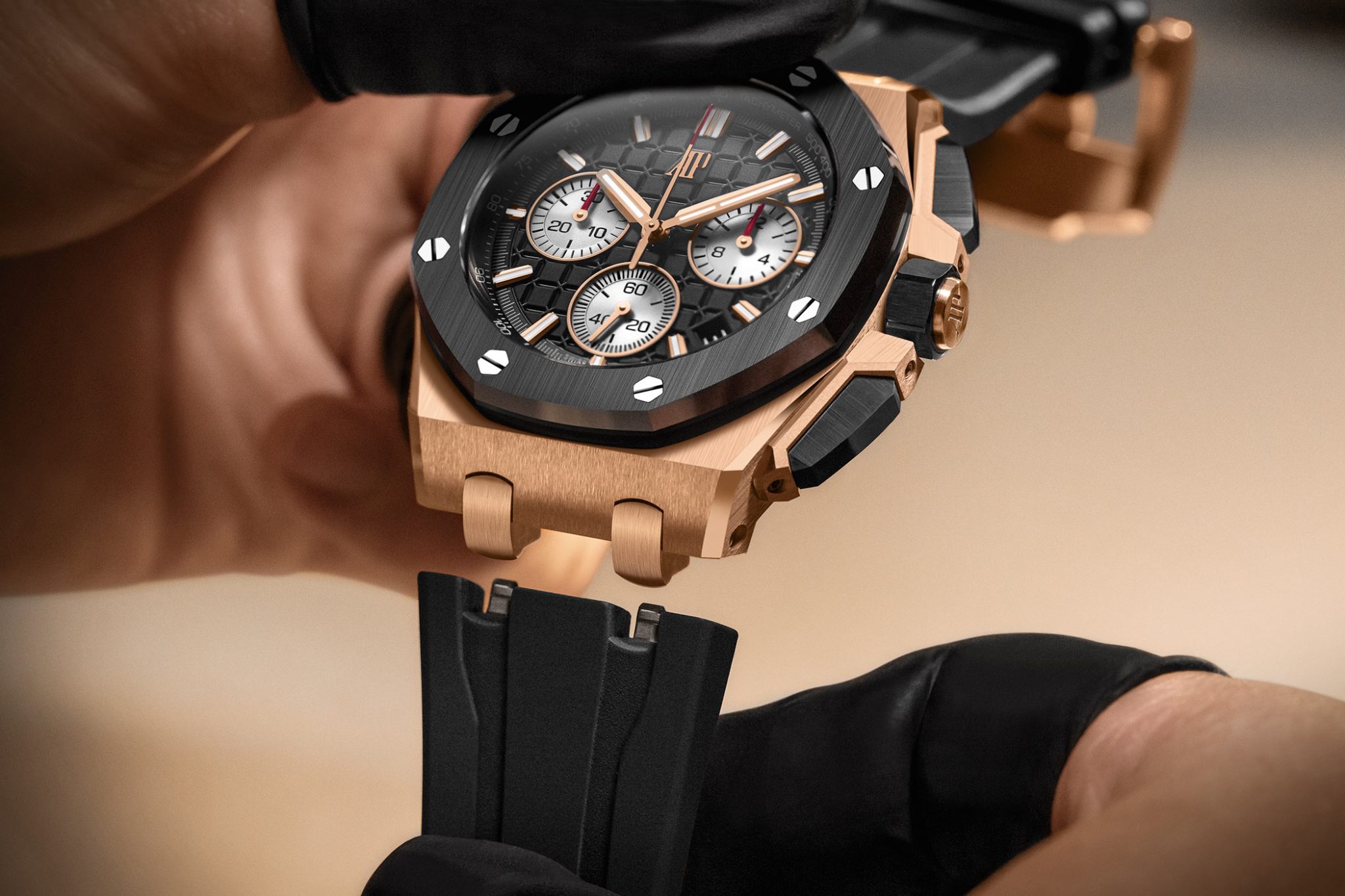
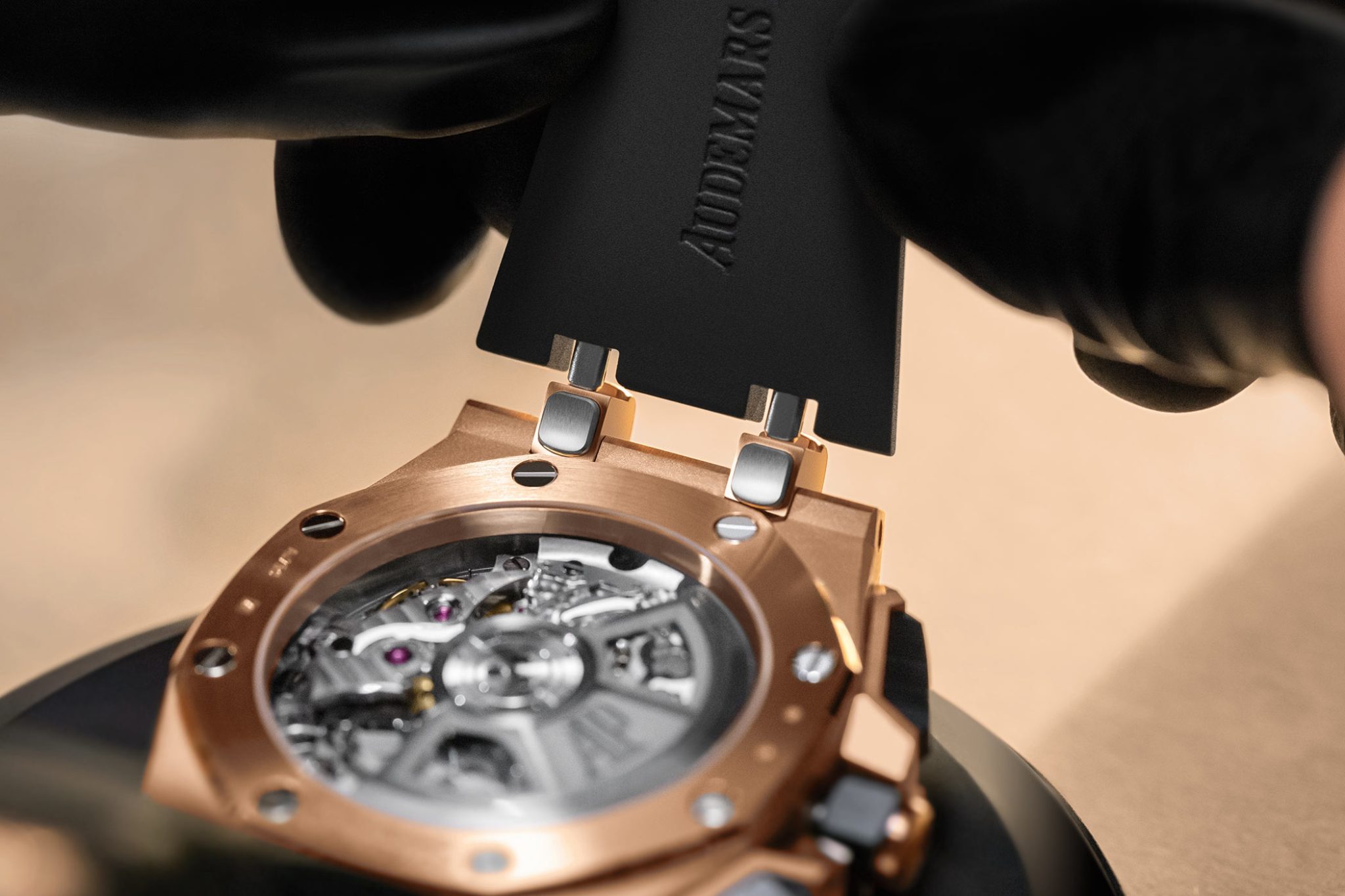
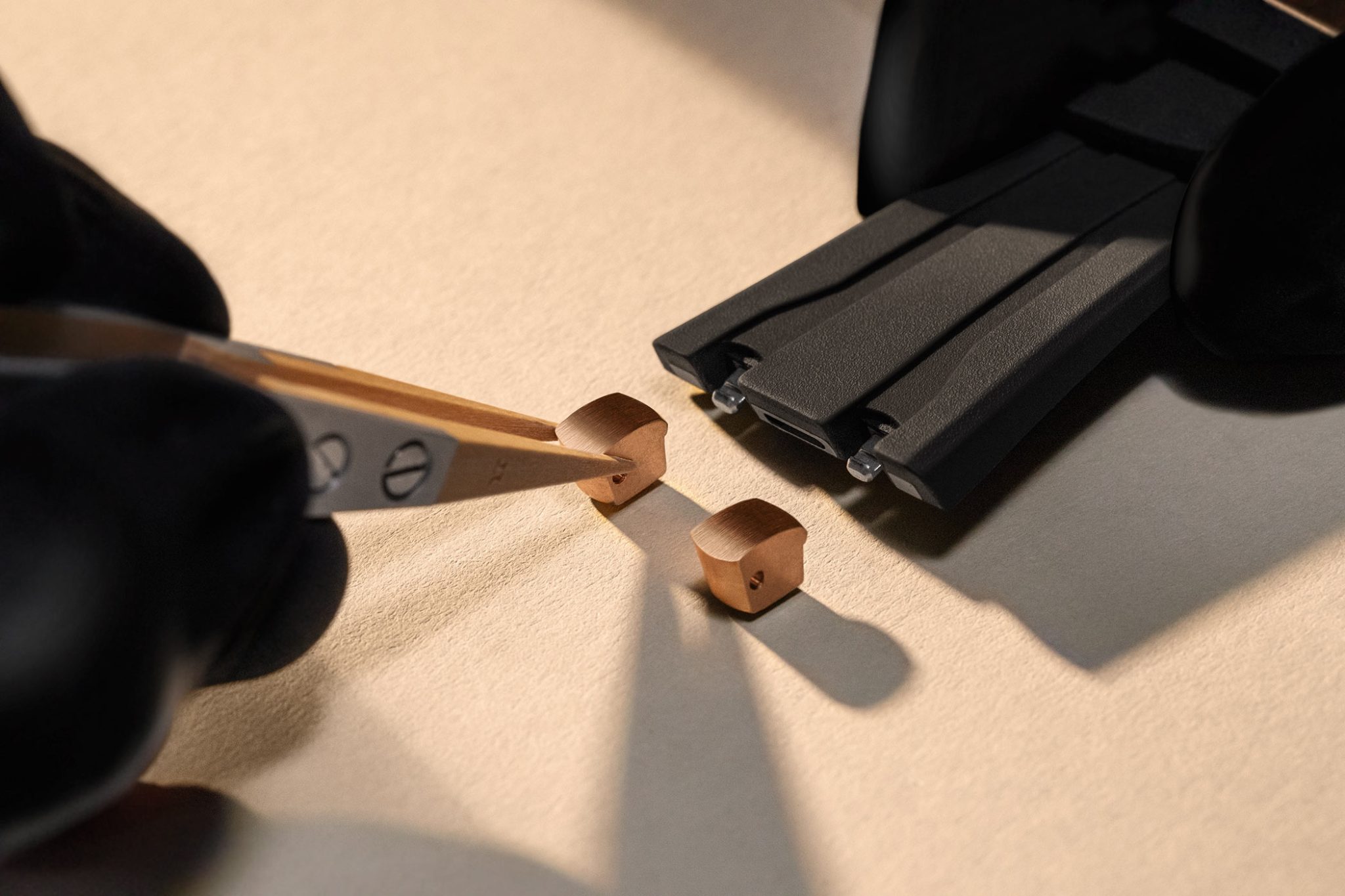
An array of combinations
So what are the options out there? To put it simply, there are two stainless-steel options (both costing 37,400 euros), two titanium options (36,400 euros), and one rose-gold edition (56,000 euros).

Of the steel options, one confidently comes with a black dial plus a matching ceramic bezel and strap (26420SO.OO.A002CA.01). The other steel edition features the same black ceramic bezel, plus a military-vibe light brown dial and matching rubber strap (26420SO.OO.A600CA.01). Both look (and feel) sporty and legible, featuring either rhodium-toned or black subdial counters.
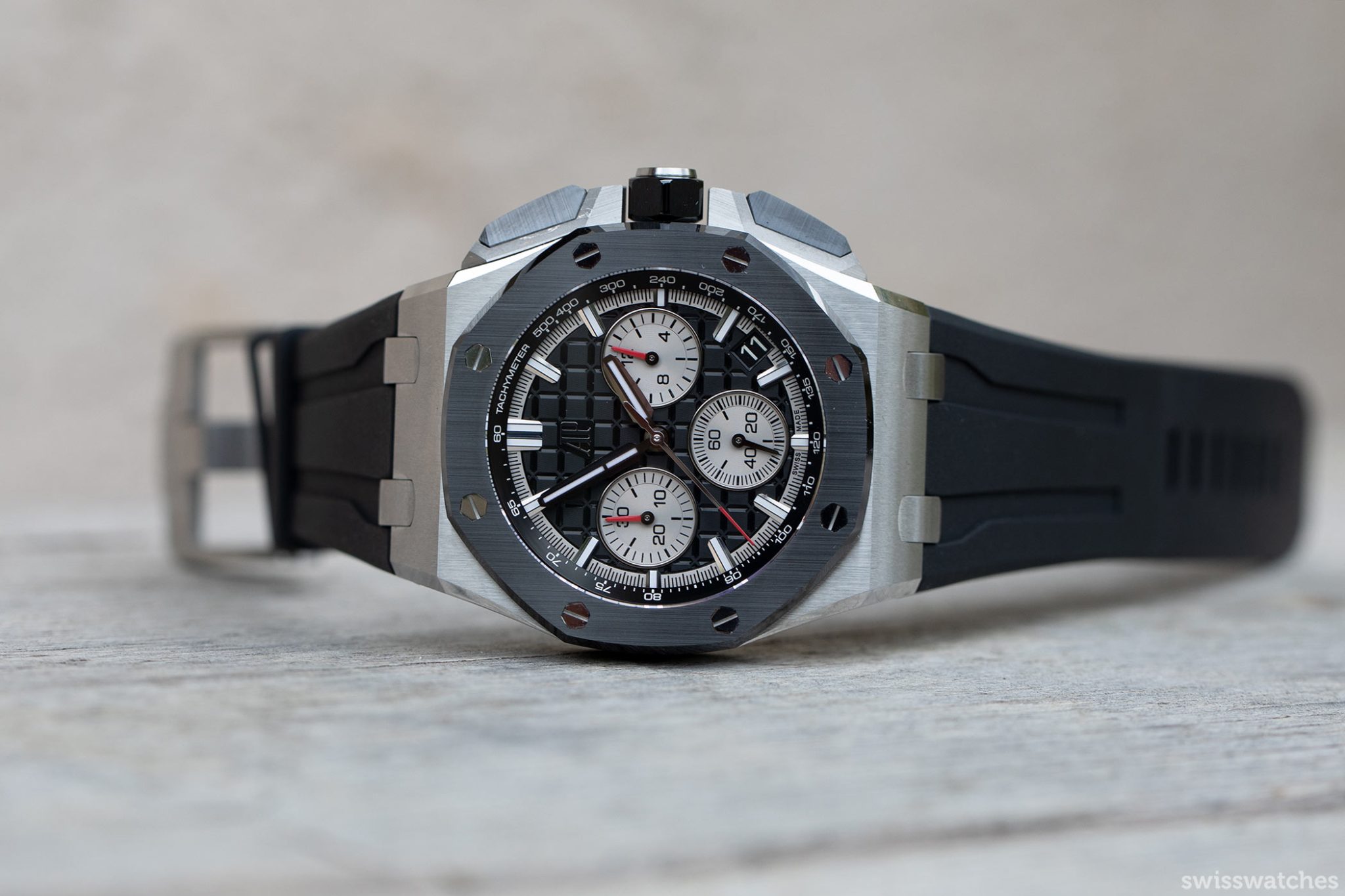
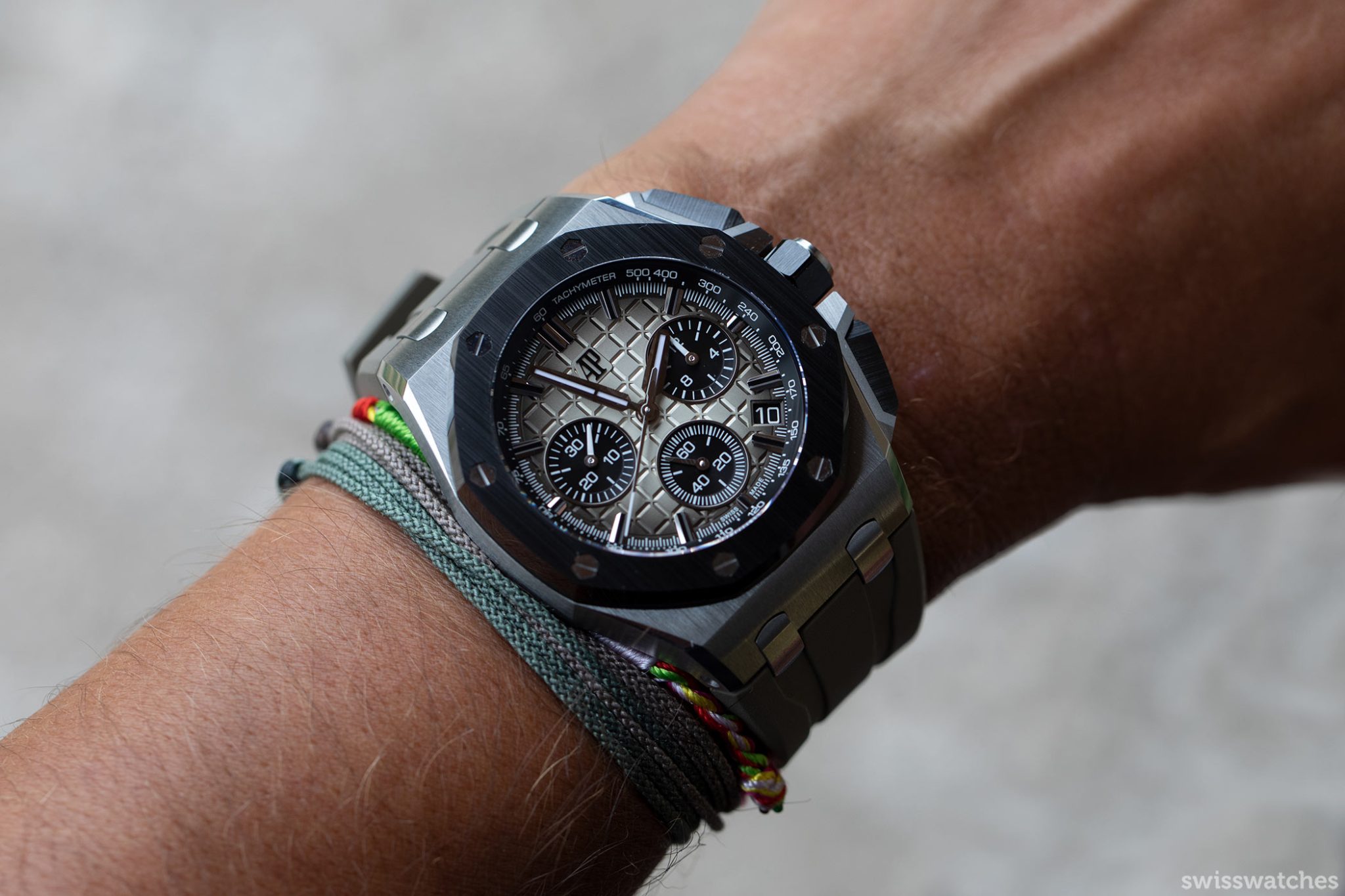
Meanwhile, one of the titanium versions comes with a trendy blue dial, matching rubber strap, and titanium bezel (26420TI.OO.A027CA.01). Alternatively, the other titanium Offshore has a more low-key grey dial plus a matching rubber strap, grey ceramic bezel, and blue subdial counters (26420IO.OO.A009CA.01). Returning to the matter of materials; one (such as myself) might argue that titanium doesn’t quite work in this specific collection, given that the Offshore is ultimately all about presence on the wrist. For others, however, the combination of light-weight titanium and the fast-paced Offshore might just equal the dream design.

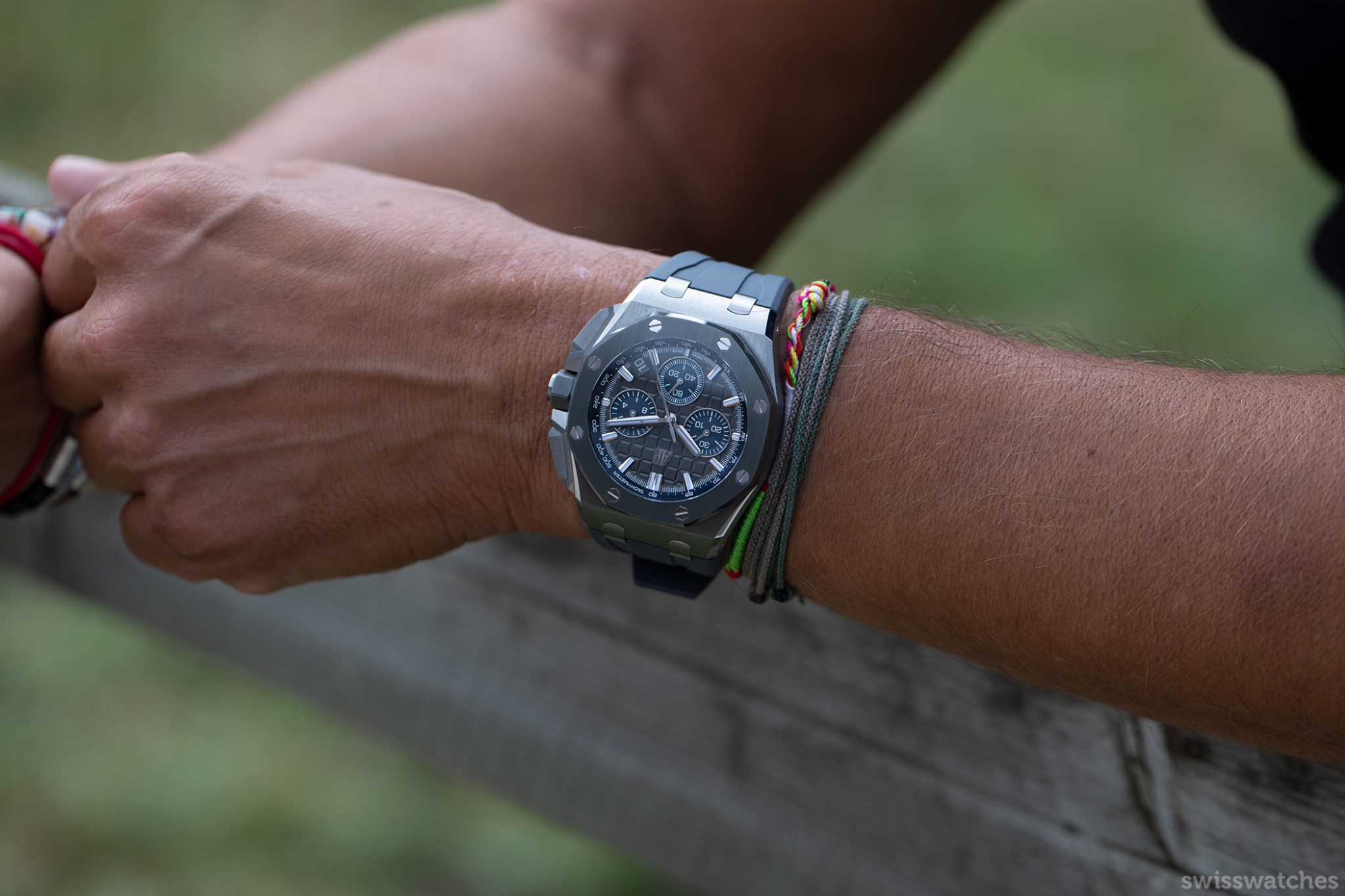
Last but not least, a glowingly eye-catching 18-carat pink-gold version with a black dial features rhodium-toned subdial counters and a black ceramic bezel (26420RO.OO.A002CA.01). While the other Offshore watches come with an additional rubber strap, this elegant edition tellingly comes with an additional black alligator leather strap.
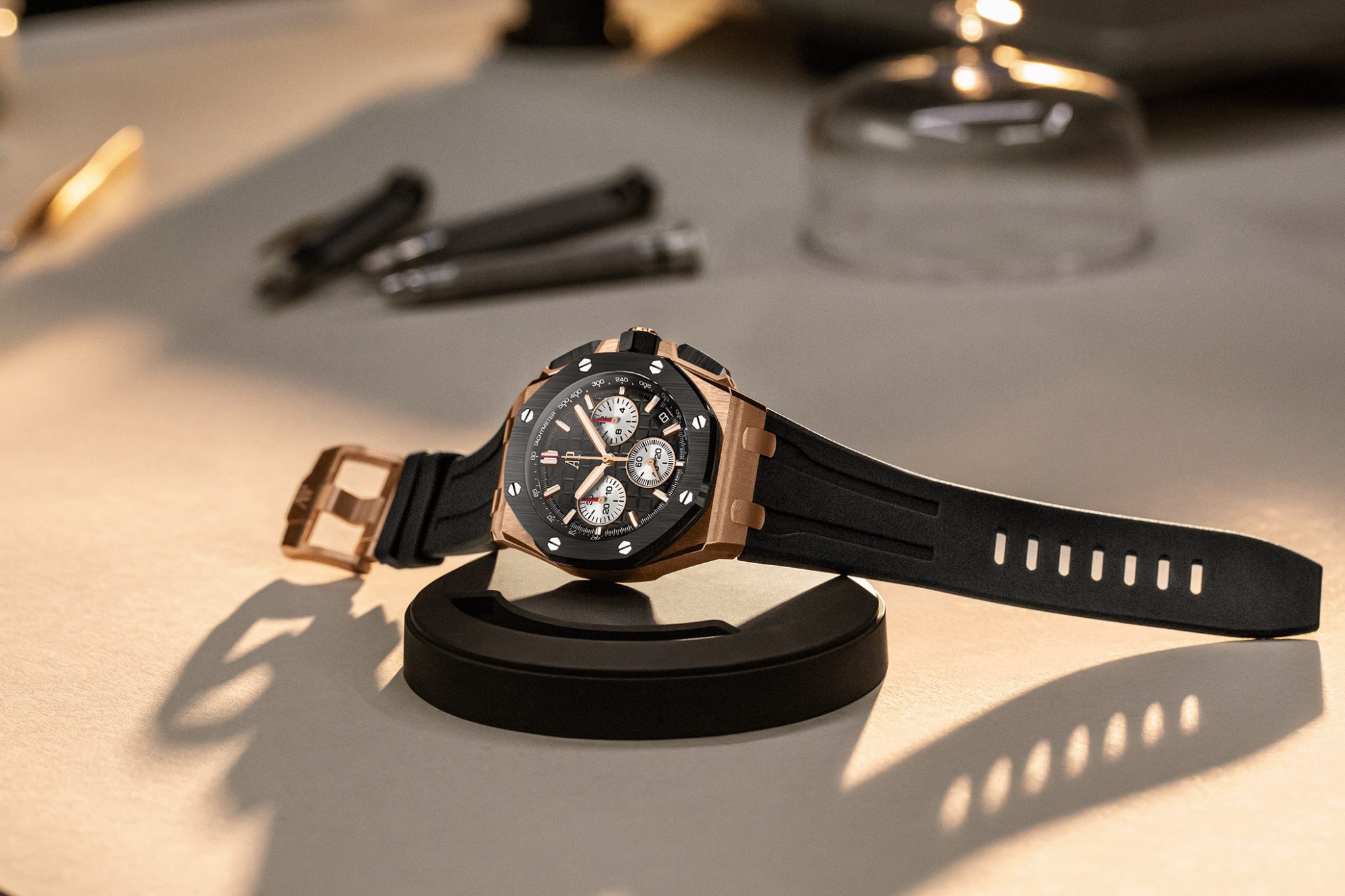
Royal Oak Offshore 43 mm: The Verdict
The introduction of the new 43 mm Offshore models shows that this collection prides itself upon refusing to stand still. There is, undoubtedly, no chance of this model languishing anytime soon. If anything, the new models are a breath of fresh air in what is already a consistently high adrenaline collection. The magic of the Royal Oak Offshore is that pretty much since its conception, these watches have been open for experimentation. The joy of this is that arguably, AP really can’t go wrong; people are aware that every new watch is like marmite, delighting some and perturbing others.

That said, there’s little not to like about the new models for those who are Offshore fans anyway. The ‘ergonomic’-focused design comes through strongly, providing an extra dose of legibility, masculinity, and powerful character. These are all things that Offshore fans look for. Additionally, it is excellent news that the line is finally using a chrono calibre created fully in-house. In fact, it may even be something that wins over a new generation of customers and purists previously focusing on the main Royal Oak collection.

